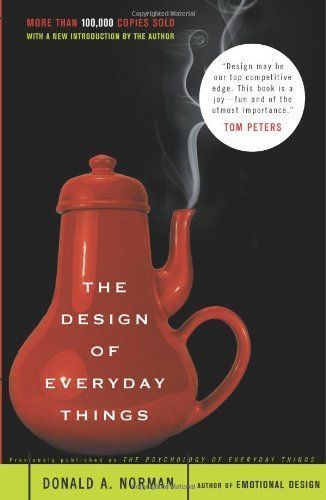
The Design of Everyday Things Revised and Expanded Edition
Design doesn't have to complicated, which is why this guide to human-centered design shows that usability is just as important as aesthetics. Even the smartest among us can feel inept as we fail to figure out which light switch or oven burner to turn on, or whether to push, pull, or slide a door. The fault, argues this ingenious — even liberating — book, lies not in ourselves, but in product design that ignores the needs of users and the principles of cognitive psychology. The problems range from ambiguous and hidden controls to arbitrary relationships between controls and functions, coupled with a lack of feedback or other assistance and unreasonable demands on memorization. The Design of Everyday Things shows that good, usable design is possible. The rules are simple: make things visible, exploit natural relationships that couple function and control, and make intelligent use of constraints. The goal: guide the user effortlessly to the right action on the right control at the right time. The Design of Everyday Things is a powerful primer on how — and why — some products satisfy customers while others only frustrate them.
Reviews
Adam Waxman@ajwaxman
Timeo Williams@timeowilliams
Akash Samant@akash
Laura Mauler@blueskygreenstrees
Aamna@aamnakhan
Tanner Christensen@tannerc
matej yangwao@yangwao
Rahma Ali@rali
Albert Dong@albertdong23
S@benhur
Ben Jenkins@benjenkins
Roberta Falco@robertafalco
Nelson Zagalo@nzagalo
Adam@adam
Dave Perkins@tallyhoooooo
Irene Alegre@irenealegre
Angel Martinez@angxlmartinez
Karl Fernandes@karlfernandes
Lissa Aguilar@l4st4ct
Barry Hess@bjhess
Bryan Maniotakis@bryanmanio
Maria@mersibaq
Clara Jo@clarajohenry
Maggie Delano@maggiedelano
Highlights
feyza nur@fndemirci
Sam Skurka@last_heir_83
Page 42
Sam Skurka@last_heir_83
Page 25
Sam Skurka@last_heir_83
Page 15
Sam Skurka@last_heir_83
Page 14
Maulana Hilmi Arkan@hilmi
Page 13
Joasia Fidler-Wieruszewska@fidlerowna
Joasia Fidler-Wieruszewska@fidlerowna
Joasia Fidler-Wieruszewska@fidlerowna
Joasia Fidler-Wieruszewska@fidlerowna
Joasia Fidler-Wieruszewska@fidlerowna